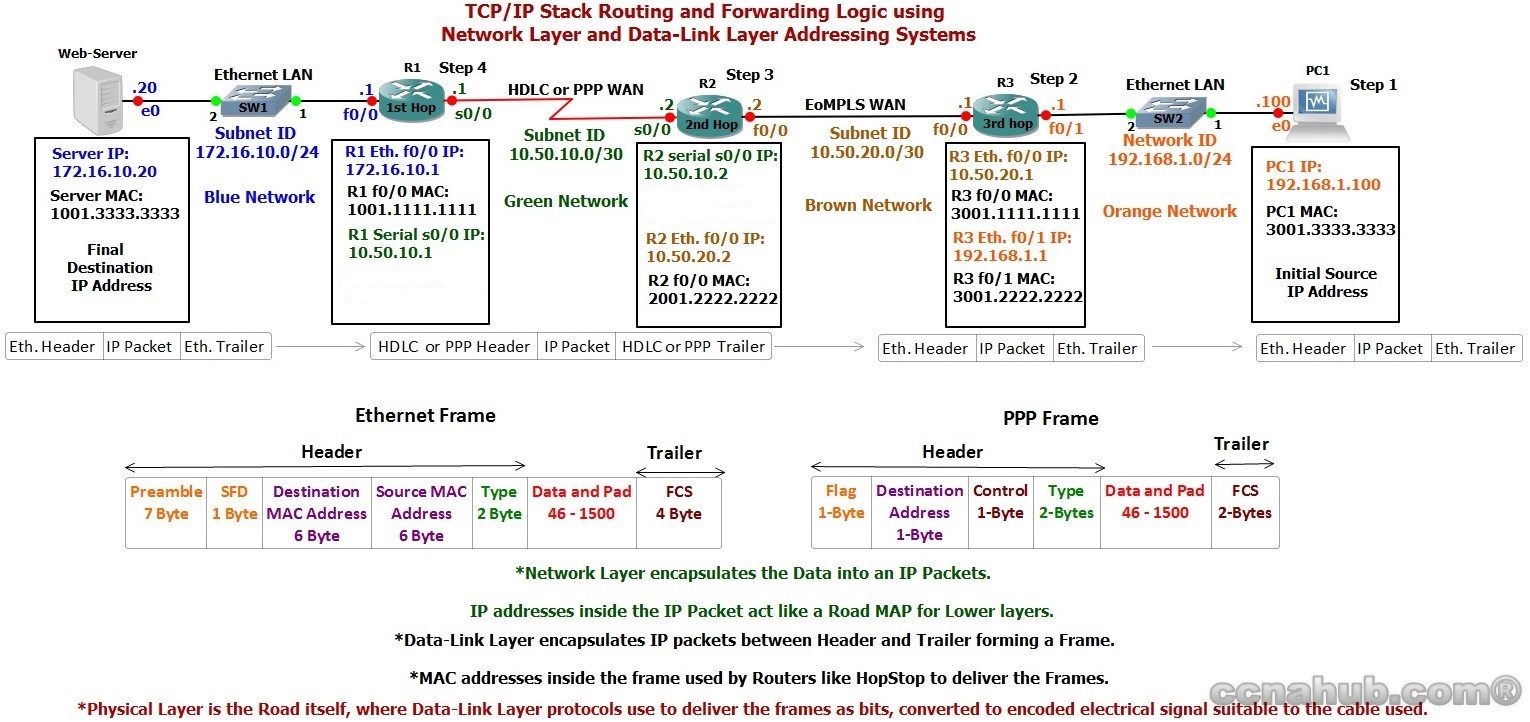CCNA Routing and Switching
<< IP and Network Fundamentals Course
>> Models, Protocols, and Standards Section
- Understanding TCP/IP and OSI Models
- Understanding Packet Flow Across the Network Part1
- Understanding Packet Flow Across the Network Part2
- Understanding Ethernet LAN Standards
- Understanding Ethernet MAC Addresses
- Understanding WAN Technologies
- Understanding Data Link Layer Encapsulation
- Understanding EoMPLS WAN Technology
- Understanding IP Routing Process Concept
- Understanding Web Browser DNS Lookup
- Understanding ARP Broadcast Message
- Understanding TCP and UDP Protocols
- Understanding TCP and UDP Multiplexing
- Understanding Application Layer Services
- Understanding Quality of Service Concept

Understanding IP Routing Process Concept explains how Routing and Forwarding decision is made based on intelligent information. Network Layer is the decision makers when it comes to IP Packet Routing, Data Link Layer takes care of Frame Forwarding. When it comes to IP packet routing, action is based on IP Protocol, Network cost, Routing Table, Next Hop, cabling, and other factors. In case of Frame forwarding, action is based on encapsulation method, Layer 2 protocols, ARP and MAC, and other factors such is it LAN or WAN.
Having said this, IP Address, Routing Table, and a suitable Routing Protocol should be in place to achieve a successful IP Packet Routing. Physical cabling connectivity for either PPP, HDLC, or Ethernet should be in place for successful Frame Forward. If Ethernet is used, MAC address and ARP table are 2 main components of Ethernet communication.
Table of Contents
IP Routing and Frame Forwarding
As mentioned, IP Routing or Frame Forwarding based on protocols to determine the best path the Packet can follow in order to travel across multiple networks from its source to its destination.
In case of Layer 3, set of protocols run together at the Network Layer to help hosts and routers route IP packets. IP Routing will involve too many network devices to accomplish an IP Packet’s Routing.
In case of Layer 2, set of protocols as well run together at the Data Link layer to handle the IP packets to the next hop. Switches, Firewall, and Routers – all of them at Layer 2 will be involved to forward Frames that carry IP Packets using either Ethernet, HDLC/PPP, or Frame Relay Technology.
Note: I have used the word “IP Packet Routing” at Layer 3 and the word “Frame Forwarding” at Layer 2 to distinguish between the 2 operations. In the end, Routing and Forwarding means the same thing for too many people.
Network Layer deals with ONE protocol to Route Packets
Network Layer defines set of functions based on One Major Logical Protocol. There are two versions of this logical protocol where other layer 3 functions revolve.
IPv4 and IPv6, both define network layer logical routing functions, but with different details for each. This article focuses on IPv4. Internet Protocol (IPv4), and as a Layer 3 protocol, focuses on Routing the IP packets that carry the Data from the upper Layers as source device to the destination device using Dotted Decimal Notation – known by Logical Addressing or IP Addressing System, then IPv4 Routing handle the Packets to the Data-Link for Framing and finally Physical Layer for transmitting frames as Bit Stream.
What are the required components for IPv4 Routing to happen?
- The Router itself – the Hardware Piece
- Router Operating System – Internet Operating System (IOS)
- IP Addressing System based on Dotted Decimal Notation
- Routing Protocols – such OSPF or EIGRP creates and maintains an Internet Road Map using IP Addressing System as reference Points
Now, Routers can guide what is called “IP Packet” to reach its final destination using an Internet Road Map built by OSPF or EIGRP using IPv4 Addressing System.
IP Routing vs. GPS Routing
If GPS Routing Guides Human to drive their car from point A to point B, then IP Routing Guides Routers to Route (drive) IP Packets (cars) from point A to point B. If Human understood how to use GPS Road Map, then Routers running Routing Protocols such OSPF or EIGRP understood how to use Internet Road Map.
Routing Protocols
Create, maintain, and present to the Router an Internet Road Map using IP Addressing System similar to GPS Map Reference Points. Every Router loaded with the required components to understand IP Routing Internet MAP.
Routers can be dedicated Hardware like Cisco or Software base running in Linux box using the same exact Routing Protocols to create, maintain, and present Internet MAP for the Router to use.
A Road MAP system like GPS device won’t really care which method you would use to reach point B, rather, it cares how to represent the right and the closest path to reach point B; it’s up to you to choose which moving method to use, you can walk, fly, ride a bus, car, or train, hence, different Layers.
So, Network Layer uses a Universal logical Protocol called either IPv4 or IPv6 to manage the IP Addressing System; Routing Protocols in the other hand such OSPF and EIGRP Create and Maintain an Internet Road MAP using the IP Addressing System as Reference Points called: Public IP Addresses.
IPv4 or IPv6 logical addresses are used to route packets based on Routing Protocols from point A to point B across different types of networks regardless of their physical structure type.
Imagine that your job is to route people from point A to point B as tourist guide, what will always concern you the most is your MAP accuracy and not how the people will be riding or walking from point A to Point B.
There will be another guy (A Data-Link Protocol) who would instruct the tourist to dress special shoes maybe at certain areas and to ride a special car maybe (Physical Cabling) to tour around special Mountain areas.
Finally IPv4 manage Logical Addressing or IP Addressing combined with Routing Protocols such OSPF or EIGRP is similar to GPS System combined with Satellite geographical reference points, but it guides IP Packets instead of Humans.
Picking the Best IP Route
Router’s logic uses a database table called IP Routing Table, to route Packets from Public IP Address to another Public IP Address, or from Network to Network; the routing table lists IP addresses as groups or blocks, called IP Networks (referring to Classful Addressing) or IP Subnets (referring to Classless Addressing).
Some of these addresses were directly learned due to directly and physically connected Networks, and some were learned using Dynamic and Multicasting Routing Protocols such OSPF or EIGRP.
IP Routing Table can be filled as follows:
1. Static Route Entries: Routing tables can be filled manually by the Network Engineer.
2. Directly Connected Route Entries: Physically connected links entries automatically get populated by the router once you configure the IP address on the interface.
3. Dynamic Route Entries: Routing Protocol such OSPF or EIGRP is used to shout and inform all neighbors’ routers about its directly connected routes
One of the main and major jobs of the any Routing Protocol is: to dynamically shout and Multicast the physically connected routes to other routers, so they can fill their Routing Table with Entries to build an Internet MAP.
When a router receives an IP packet at its Network Layer, it compares the packet’s destination IP address to the entries on the Routing Table and makes a match. This matching entry also lists directions such the exit or via interface to tell the router where to route the packet next.
So how Routers Route IP Packets?
When the frame arrives at LAN or WAN interface, the router or PC uses the following logic on the data link frame:
Step 1: Use the data link Frame Check Sequence (FCS) field to ensure that the frame had no error; of errors occurred, discard the frame.
Step 2: If the frame was not discarded at Step 1, de-encapsulate the frame by striping it and discarding its old data link header and trailer, leaving the IP packet.
Step 3: If it’s a router device, it compares the IP packet’s destination IP address to the routing table, and find the route that best matches the destination address. If successful, the route will identify the outgoing interface for the IP packet to exit.
Step 4: Once routing decision is made, encapsulates the IP packet inside a new data link header and trailer (New Frame), with the router’s source MAC address of the outgoing interface and a destination MAC address of the next hop based on ARP table, and forward the frame to the next-hop. The next-hop could be another router or PC.
Note: keep in mind that routers sometimes uses WAN links with protocol either HDLC or PPP, in this case they don’t use source or destination MAC address, instead, they use different method then MAC address.
PC Routes IP Packets as Well
All network devices such Routers and PCs work together to perform IP routing. The host’s OS has software TCP/IP stack, PCs use this software networking model to choose where to send IP packets, usually to a nearby router if the host they are trying to reach is located on different Subnet. Together, hosts and routers deliver the IP packet to the correct destination using the Module – TCP/IP Stack.
How PCs uses routing logic to Route IP Packets?
Step 1: If the destination IP address is in the same IP subnet as I am, forward the IP packet using Ethernet Frame directly to the destination host, hence, no need for default gateway. However, IP is always needed in either case, so hosts can learn MAC addresses from each other.
Step 2: Otherwise, route the IP packet to my default gateway as next-hop using Ethernet Framing as well for further routing, if the Host located at different subnet then mine.
Address Resolution Protocol (ARP)
Ethernet network devices need the help of Address Resolution Protocol (ARP) to be able to Route Frames either internally or outside the Network. ARP as a Network Layer feature is used only for Ethernet network devices to learn MAC addresses from each other.
PCs and Routers must have some way to decide what MAC address to use while building the frame on the downstream of TCP/IP stack. ARP dynamically learns the data link (MAC) addresses of hosts/routers connected to LAN through broadcast address ffff.ffff.ffff.
ARP cache expedite the Data-Link Layer to assign destination and source MAC addresses while building the frames.
Detailed Steps: PC1’s ARP learning R3’s MAC address for the first time
In order to send to outside Networks such a web-server, PC1 knows that it has to send its packets through default gateway (R3) to reach the web-server. Therefore, and for the first time, it has to send out an ARP broadcast message asking R3 for its MAC address.
R3 receives the ARP broadcast message and replies with its f1/0 interface MAC address. Later, when PC1 wants to route packets to the web-server through R3, it will include the IP address of the web-server as destination IP address at the Network Layer, and includes the MAC address of R3 as next hop to delivery IP Packet request.
Based on the Image below
Step1: PC1’s Network Layer creates an IP packet using R3’s IP address (192.168.1.1) as destination IP Address, and using PC1’s IP address (192.168.1.100) as source calling for ARP broadcasting message.
Step2: PC’1 Data-Link receives, analyze, and encapsulates the IP packet as frame, adds a broadcast destination MAC address of (FFFF.FFFF.FFFF) as unknown receiver (since PC1’s ARP table still doesn’t know R3’s MAC Address), adds PC1’s source MAC address as a sender, and finally forwards the frame using PC’1 NIC interface as outgoing interface through the physical layer heading to everyone in the network.
Step3: SW2 receives the frame and floods the broadcast message (Since it’s FFFF.FFFF.FFFF MAC Address) from all ports except the incoming port. As a result, R3 receives the ARP broadcast message and replies back to PC1 by its MAC address (3001.2222.2222). PC1’s ARP table now knows about R3’s MAC address and saves in its cache be used for any outside request such Web Server.
While PC1 requesting Webpage from a web-server, it analyzes the destination IP address of the web-server and realize that web-server address (172.16.10.20) is not on the same LAN as PC1, hence, PC1’s TCP/IP logic tells PC1 that you must route the packet to a nearby router which located on the same LAN called Default Gateway.
To route the IP packet through default gateway, and after learning R3’s MAC Address, PC1 forwards the frame across an Ethernet cable to the nearby router which includes the Application Layer Data (GET Message) inside an IP packet, framed using Ethernet MAC Address for further routing. Finally, PC1’s frame which include the IP Packet, hit R3’s LAN interface port as next-hop for further routing.
Subject Related
By Wikipedia Routing | Router Ally Routers | HighTech Layer 3 | Think Like a Computer IP Routing | R&S ICND1 and ICND2 | Introduction To Network | Practical Packet | Computer Network | Introduction to Networking | Who is Running the Internet | Networking Self-Teaching Guide
CCNA Routing and Switching
<< IP and Network Fundamentals Course
>> Models, Protocols, and Standards Section
- Understanding TCP/IP and OSI Models
- Understanding Packet Flow Across the Network Part1
- Understanding Packet Flow Across the Network Part2
- Understanding Ethernet LAN Standards
- Understanding Ethernet MAC Addresses
- Understanding WAN Technologies
- Understanding Data Link Layer Encapsulation
- Understanding EoMPLS WAN Technology
- Understanding IP Routing Process Concept
- Understanding Web Browser DNS Lookup
- Understanding ARP Broadcast Message
- Understanding TCP and UDP Protocols
- Understanding TCP and UDP Multiplexing
- Understanding Application Layer Services
- Understanding Quality of Service Concept


I find the article useful in understanding the routing process, however I can not find the image mentioned by "Based on the image bellow".